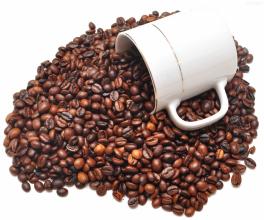Espresso roasted coffee beans by grinding several degrees of powder at Starbucks
Espresso roasted coffee beans by grinding several degrees of powder at Starbucks
Mellow [Body]: the taste of the tongue after drinking coffee. The change of mellowness can be divided into light to light, medium, high, fat, and even some Indonesian coffee is as thick as syrup.
Odor [Aroma]: the smell and aroma emitted after the coffee has been prepared. The words used to describe smell include caramel, carbon roast, chocolate, fruit, grass, malt, and so on.
Bitterness [Bitter]: bitterness is a basic sense of taste, and the sensory area is distributed in the base of the tongue. The bitterness of deep baking is deliberately created, but the common cause of bitterness is too much coffee powder and too little water.
Light [Bland]: coffee grown in lowlands, usually quite light and tasteless. Coffee with insufficient coffee powder and too much water will have the same light effect.
Salty [Briny]: after brewing, if the coffee is overheated, it will produce a salty taste.
The aroma of soil [Earthy]: commonly used to describe spicy and earthy Indonesian coffee, not the smell of dirt on coffee beans.
Uniqueness [Exotic]: describes coffee with its unique aroma and special flavor, such as flowers, fruits, and spices. Coffee from East Africa and Indonesia usually has this property.

Important Notice :
前街咖啡 FrontStreet Coffee has moved to new addredd:
FrontStreet Coffee Address: 315,Donghua East Road,GuangZhou
Tel:020 38364473
- Prev

Geographical characteristics of Xiaqisuo producing area of sun-exposed Sidamo coffee beans
[baking weight loss rate]: 12.5%. [baking degree]: City (shallow roasting) [bean roaster parameters] Taiwan Pegasus coffee bean roaster 801N/1kg semi-hot air / semi-direct coffee frying machine sipping: brilliant blueberry camellia aroma, strawberry cherry fresh fruit aroma, light fruit wine, round melon and fruit, apple fruit sweet, bright acidity, low acidity, complex multi-layer, non-
- Next

Who are the members of the American Specialty Coffee Association? American Specialty Coffee Association SCAA
SCAA is the world's largest and most authoritative coffee trade association. SCAA awards companies and individuals who have made outstanding contributions to the coffee industry every year. These awards include: Lifetime Achievement Award, Special Contribution Award, Outstanding Author/Publisher Award, Special Certification Award (Individual), Sustainable Development Contribution Award; Golden Cup Award (Cafe, Retailer)/
Related
- Detailed explanation of Jadeite planting Land in Panamanian Jadeite Manor introduction to the grading system of Jadeite competitive bidding, Red bid, Green bid and Rose Summer
- Story of Coffee planting in Brenka region of Costa Rica Stonehenge Manor anaerobic heavy honey treatment of flavor mouth
- What's on the barrel of Blue Mountain Coffee beans?
- Can American coffee also pull flowers? How to use hot American style to pull out a good-looking pattern?
- Can you make a cold extract with coffee beans? What is the right proportion for cold-extracted coffee formula?
- Indonesian PWN Gold Mandrine Coffee Origin Features Flavor How to Chong? Mandolin coffee is American.
- A brief introduction to the flavor characteristics of Brazilian yellow bourbon coffee beans
- What is the effect of different water quality on the flavor of cold-extracted coffee? What kind of water is best for brewing coffee?
- Why do you think of Rose Summer whenever you mention Panamanian coffee?
- Introduction to the characteristics of authentic blue mountain coffee bean producing areas? What is the CIB Coffee Authority in Jamaica?

